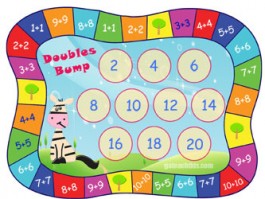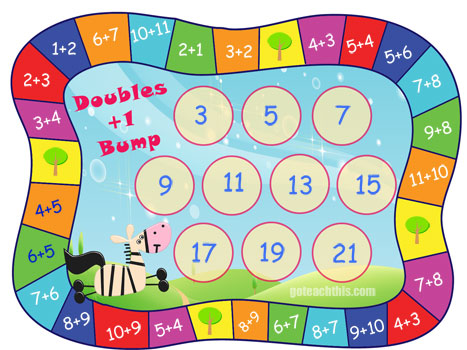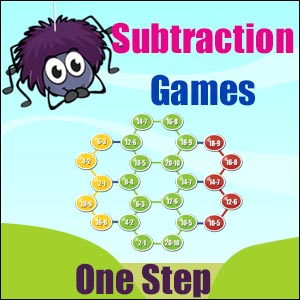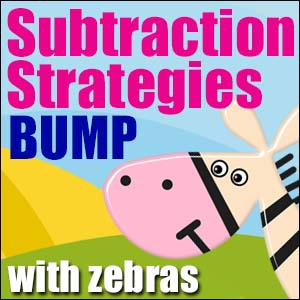Addition Game
Bump – Printable & Video Game

Addition Game – Bump – with Zebras:
Two players race around the outside track answering algorithms as they go. On giving the correct answer the students place one of their counters on the algorithm’s answer in the center of the board. The game is ideal for practicing Addition Basic Facts and for developing number strategies.
What You Need:
2 Players
1 Bump Board
2 playing pieces (eg counters, coins, small rocks, game pieces)
5 transparent counters per player
1 die marked 1-6
Game Set-Up:
Players sit facing the board with their 5 counters in hand. Each player chooses a different tree as their starting point on the board and places their game piece on it.
NB The students must decide if they go around the board clockwise or anticlockwise. (For no other reason but to provide a context to learn the terms ‘clockwise’ and ‘anti-clockwise’) hehehehe

How to Play:
The Bump Rule:
The Locked-In Rule:
Teachable Moment:
NB There is no such thing as, ‘Doing sums’.
Discussion:
How to Win:
Organization Hints:
Conduct Number Talks Before and After the Game:
A ‘Number Talk’ is a 5 to 15-minute class discussion. It focuses on the efficient use of number strategies to solve problems. The teacher and students talk about problem-solving strategies to explore and expose the group to new ways of thinking. The talks serve to deepen mathematical understandings and develop computational fluency.
A Possible Number Talk Strategy:
Write up any algorithm the students may encounter during the playing of the game eg 5+6=
– have the students discuss honestly with a partner how they would solve it.
– how would your teacher want you to solve it? Why?
– 5+5+1 or 6+6-1 which strategy do you like? Why?
– Do you have another way of working this out that is quick and accurate? Share it with us?
Base Number Talks on Observed Behaviours:
– When you see a lot of ‘Counting On’ to solve the algorithms, encourage the practicing of efficient number strategies.
– The game flows well when you use Skip Counting when going around the board. True or False? Explain your answer.
– ‘Efficient’ means getting to the answer as fast as possible and the use of Mathematical strategies will help you achieve this aim. When you throw a 6 do you count by ones or twos? Which one is quickest and still accurate? Demonstrate.
– How could you skip count if you threw a 5? 2+2+1, 1+2+2, 2+3. Is this faster than counting one at a time?
– Tell your partner what strategy you could use for when you throw a 4.
Possible Journal Reflections:
I enjoyed playing the Math game today because _____________
I did not enjoy playing the Math game today because __________
While playing the Math game today I figured out ________
After playing this Math game I now can __________
Based on the way I felt today in Math I need to __________
What did you discover about your use of Addition strategies while playing this game?
On a scale from 1 to 10 I rated my Math work a ______ today because________
Included in this Download:
Possible Math Journal Reflections
::: PLUS ::: a PowerPoint file to aid the teaching of the game and Number Talks.
EXPLORE MORE




